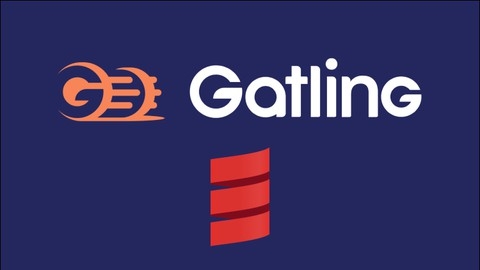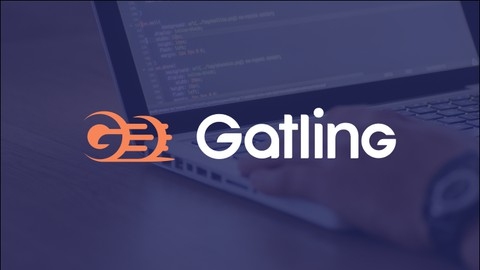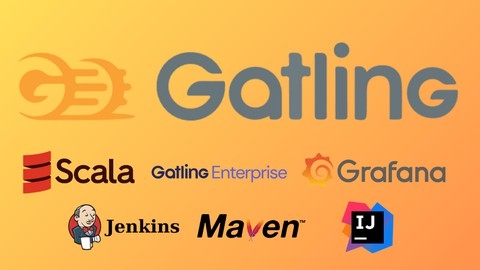Gatling is a powerful open-source load testing tool that allows you to simulate massive user traffic to your web applications, APIs, and microservices.
By using Gatling, you can identify performance bottlenecks, optimize your system’s capacity, and ensure a smooth user experience even under heavy load.
Learning Gatling empowers you to build robust and scalable applications that can handle real-world traffic demands.
Finding the right Gatling course on Udemy can be challenging, given the variety of options available.
You’re looking for a course that provides a comprehensive understanding of Gatling, from basic concepts to advanced scripting techniques, while also offering practical examples and hands-on exercises.
Based on our research, we believe Gatling Fundamentals for Stress Testing APIs - Scala - 2022 is the best Gatling course on Udemy overall.
This course offers a comprehensive introduction to Gatling, using Scala for scripting, and covers a wide range of topics from recording user scenarios to analyzing test results.
It’s well-structured, easy to follow, and provides practical examples that you can apply to your own projects.
However, we understand that you might have specific needs and preferences.
That’s why we’ve compiled a list of other excellent Gatling courses on Udemy that cater to different skill levels and learning styles.
Keep reading to explore our recommendations and find the perfect course to master Gatling and elevate your performance testing skills.
Gatling Fundamentals for Stress Testing APIs - Scala - 2022
This course takes you on a journey from Gatling newbie to confident performance tester.
You start by installing Gatling and using the Gatling Recorder to capture user actions and transform them into Gatling scripts.
You’ll then create your first Gatling project from scratch, writing scripts, adding pauses, checking response codes, and even extracting data from those responses.
You’ll learn how to make your scripts smarter by reusing code, looping through HTTP calls, and handling user authentication.
You’ll master the art of Gatling feeders, using them to manage test data efficiently, and even explore advanced techniques like creating custom feeders and templating files.
The course doesn’t shy away from real-world scenarios, teaching you how to design different types of load simulations, such as ramping up users or running tests for specific durations.
You’ll become comfortable running these tests from the command line, tweaking them with runtime parameters to fit your exact testing needs.
Finally, you’ll discover how to monitor your tests in real time, analyze the detailed reports generated by Gatling, and integrate your testing workflow with popular continuous integration tools like Jenkins and Travis CI.
You’ll connect your code repository on GitHub, set up automated test executions, and even learn how to trigger these tests automatically.
You’ll even discover how to leverage the power of cloud platforms like AWS, Azure, and Google Cloud Platform to run your Gatling tests on services like EC2 or Lambda functions, giving you the flexibility to test your APIs in diverse environments.
Gatling Fundamentals for Stress Testing APIs - Java - 2022
This course begins by laying a strong foundation in Gatling, guiding you from installation to setting up a development environment using Maven.
You learn by doing, using the Gatling Recorder to capture API interactions and then diving into Gatling scripting fundamentals.
This includes adding pause times, checking response codes, and extracting data using JSONPath and JMESPath.
You’ll discover how to structure your scripts efficiently using methods and loops, and handle authentication for testing secured APIs.
You then transition into load simulation design, exploring techniques like ramp users and fixed duration simulations to mimic real-world user behavior.
The course introduces you to using various feeders like CSV and JSON feeders, empowering you to generate realistic data for your tests and even build custom feeders for complex scenarios.
You’ll learn to execute your scripts from the command line using Maven and gain practical experience in analyzing the results to gain performance insights.
The course culminates in a final challenge where you apply your acquired knowledge to a real-world scenario.
This practical exercise reinforces your understanding and provides valuable feedback on your solution.
Through this hands-on approach, you develop the skills to design, execute, and analyze performance tests using Gatling, preparing you to confidently tackle real-world API stress testing challenges.
Performance Testing Using Gatling
This Gatling course teaches you how to test how well websites and applications work using code.
You’ll begin by mastering the basics of Scala, the language behind Gatling.
You’ll learn how to create projects, work with variables and functions, and understand how classes work.
With a strong Scala foundation, you’ll dive into the world of Gatling.
You’ll discover how to set up Gatling using tools like OpenJDK and Maven.
You’ll learn how to record scripts, which are like instructions for your performance tests, using an HTTP proxy or a HAR converter.
The course explains how to use the Gatling IDE within IntelliJ, making writing and running your tests easier.
You’ll gain a deep understanding of Gatling scripts, learning about protocols, scenarios, pauses, and checks.
The course doesn’t shy away from advanced concepts.
You’ll learn how to manage user sessions, simulate different user interactions, and handle data using feeders and expressions.
You’ll discover how to craft various HTTP requests, ensuring your tests mirror real-world user behavior.
You’ll even explore testing websockets and SSE protocols, which are used for real-time applications.
The course covers setting up distributed testing, allowing you to simulate massive loads on your application.
You’ll also learn how to integrate Gatling with Jenkins, automating your performance testing process.
Advanced Gatling for Stress Testing Web Applications - 2022
You begin with a hands-on project, the Ace Toys application, where you learn to build a Gatling development environment from scratch.
You then learn to record user journeys, simulating real user interactions to test the application’s resilience.
This involves handling user authentication, a crucial aspect of web application testing, and making sure the application responds correctly to user requests.
You then move on to building a robust Gatling framework.
This framework helps you organize your tests, making them easier to maintain and understand.
You learn to refactor different parts of the Ace Toys application, such as static pages, product listings, shopping carts, and customer accounts, into separate, manageable modules within your Gatling framework.
The course then introduces you to the world of data-driven testing with Gatling feeders.
You work with different data formats like CSV and JSON, commonly used for storing and exchanging data, and even discover how to build custom feeders for specific testing needs.
You learn to use programmatic logic within your tests using Gatling’s built-in language features.
You can control the flow of your tests, making decisions based on the application’s state, and simulate complex user interactions like adding or removing items from a shopping cart, all while keeping track of the user’s journey using session variables.
You then learn to design realistic load simulations, mimicking real-world traffic scenarios.
You learn to simulate multiple user journeys, each representing a different way a user might interact with your application, and run these journeys concurrently.
You discover how to define different test scenarios, varying the number of users and their behavior to stress test your application under different conditions.
This course also covers the use of runtime parameters, allowing you to fine-tune your tests on the fly without modifying the core test scripts.
Finally, you learn to integrate Gatling with Jenkins, a popular automation server.
This integration allows you to include your Gatling tests into a continuous integration pipeline, ensuring that your application is thoroughly tested for performance each time you make changes to your code.
Performance Testing with Gatling - Basics to Advanced
This course takes you on a journey to becoming a Gatling pro.
You start with performance testing basics, learning about crucial KPIs and metrics.
You then dive into client-server architecture, understanding how applications work behind the scenes.
This knowledge is essential for building effective performance tests.
You’ll learn how to set up Gatling, a powerful tool for load testing, and use its recorder to capture real user interactions and turn them into test scripts.
The course covers different HTTP methods, like GET and POST, and how to use them for testing different aspects of your applications.
You’ll also master advanced techniques like writing looping tests and using CSV feeders to test with large datasets, simulating real-world user behavior.
The course doesn’t just stop at the technical aspects of Gatling; it also covers integration with popular tools like Git, GitHub, and Jenkins.
You’ll learn how to manage your test scripts effectively and automate your performance testing process.
Finally, you’ll apply your knowledge by conducting performance tests on real-world applications, including banking systems, healthcare websites, and even SOAP APIs.
Master Performance Testing Gatling + Scala + Jenkins -SEP'24
This Gatling and Scala performance testing course begins by establishing a strong understanding of Scala, covering data types, variables, functions, and object-oriented programming concepts like classes and inheritance.
You then transition into learning Gatling, starting with installation and the use of the Gatling recorder to capture test scripts.
You’ll learn how to write scripts manually, edit HTTP requests, and handle authentication.
You’ll become proficient in advanced operations such as using feeders for data-driven testing and implementing injection patterns to control load tests.
The course will teach you how to set up and integrate Jenkins, a CI/CD tool, for automated test execution.
You’ll also explore Gatling Enterprise, a cloud-based platform for managing and analyzing your performance test results, and learn how to integrate it with Grafana for visualizing this data through insightful dashboards.
Through this course, you’ll master various testing methodologies like load testing, stress testing, spike testing, and endurance testing, enabling you to design realistic scenarios that mirror real-world user behavior.
You will gain practical experience using tools like Maven for project management, solidifying your skills in building a robust performance testing framework with Gatling and Scala.
Gatling - Performance, Stress, and Load testing in nutshell!
This Gatling course equips you with the skills to use Gatling for performance testing.
You will understand the differences between performance, stress, and load testing and learn how to build a test stack using Gatling, capturing the essence of simulating real-world user behavior.
The course guides you through setting up your environment, from installing Java and JDK to configuring your IDE, whether IntelliJ or Eclipse.
You’ll master the Gatling Recorder, learning to capture user interactions and create simulations, running simulations, and using HAR files for realistic testing.
You’ll explore advanced concepts like performance testing metrics, test monitoring, reporting, and analyzing results, going beyond the basics to understand different types of simulations and troubleshoot common Gatling issues.
The course emphasizes real-world application, showing you how to use Gatling for API testing and cloud testing.
You’ll gain hands-on experience with Gatling simulations, working through practical examples to analyze reports and identify performance bottlenecks.
This course prepares you to design, execute, and analyze performance tests using Gatling, making you a valuable asset in any DevOps environment.







